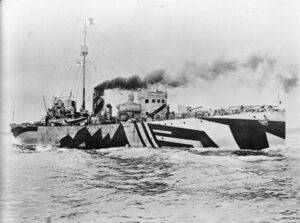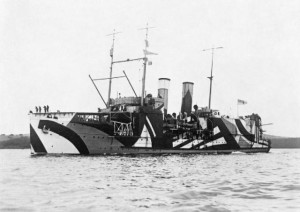 “Dazzle” camouflage (also known at the time as “razzle dazzle” or “dazzle painting”) was first used in the First World War.
“Dazzle” camouflage (also known at the time as “razzle dazzle” or “dazzle painting”) was first used in the First World War.
It was a method of providing camouflage at sea, by painting massive areas of a ship in strongly contrasting colours, using stripes, broken lines, and distorted rectangles. The idea was not to hide the ship, almost an impossible thing to do at sea, but to confuse the enemy as to the shape of the ship, its position, speed and direction.
To estimate the position of a ship, equipment known as “rangefinders” were used by gunners and submariners. These were instruments with a single eye-piece and two prisms. Looking through the eye-piece, the operator sees two half-images of the target and adjusts the mechanism until the two halves line up to form a single picture. The equipment then gives a reading of the distance the object is from the operator. It was important that the operator accurately judged when the two images combined, as just a little bit out would make the difference between a hit and a miss. “Dazzle” was intended to make that decision very hard because the clashing patterns looked abnormal even when the two halves were aligned. This became more important when submarine periscopes included similar rangefinders. As an additional feature, the dazzle pattern usually included a false bow wave intended to make estimating the ship’s speed difficult.
A British zoologist, John Graham Kerr, outlined the principle of the use on British warships to the First Lord of the Admiralty, Winston Churchill, in 1914. He said that, “It is essential to break up the regularity of outline and this can be easily affected by strongly contrasting shades … a giraffe or zebra or jaguar looks extraordinarily conspicuous in a museum but in nature, especially when moving, is wonderfully difficult to pick up”. A general order to the British fleet was issued on November 10th 1914 instructing that “Dazzle” was to be applied to British warships. It was reported by officers on board the HMS Implacable, that the pattern “increased difficulty of accurate range finding”.
However, when Churchill left the Admiralty to take up another position in Government, the Royal Navy reverted to the old standard, plain grey paint schemes. Kerr was told in July 1915, that “various trials had been undertaken and that the range of conditions of light and surroundings rendered it necessary to modify considerably any theory based upon the analogy of the coloration of animals”.

Many people who designed the artwork were artists and one was Edward Alexander Wadsworth, most famous for his association with “Vorticism”, which was a form of abstract art involving zig-zag lines, and blocks of violent colours as used in “Dazzle”. At the end of 1915, Wadsworth joined the Royal Navy Reserve and spent the rest of his war on the Greek island of Mudros designing dazzle camouflage until he was invalided out in 1917.
After the War in 1935, Wadsworth was invited by architect Serge Chermayeff to design a mural for the De La Warr Pavilion in Bexhill. Wadsworth based his design on a 1929 painting, “Shells and Cones”, a highly stylised version of a sea chart of the area. The mural was subsequently painted on the east wall of the restaurant, but due to the effect of light on the plastered wall, the mural quickly deteriorated and had to be done a second time, which also failed. Eventually it was copied on to canvas, just after 1945, by a previous member of staff at the De La Warr Pavilion. The original study now hangs in a private area of the Pavilion where the strong sunlight will not damage the painting and is loaned out as requested to museums and galleries. Today, the painting on canvas hanging in the Restaurant is a copy of the original mural produced by Wadsworth.


